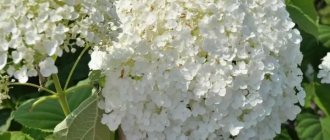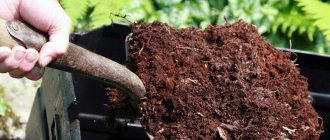Hydrangea is loved by gardeners for its stunning blooms. Also, by adding different fertilizers, you can get the desired shade of inflorescences.
Dear readers! For you, we have created communities on social networks in which useful articles and interesting ideas are published several times a day! Subscribe and receive useful content in a convenient format!
Hydrangea is a perennial, which means that every autumn the question arises about appropriate measures to prepare the shrub for winter.
In today's article we will find out what care the plant needs before the onset of cold weather.
When and how to prune hydrangeas in the fall
In general, the lower leaves from the bushes should be removed by the first days of August. This is done so that the trunk of the bush becomes as woody as possible.
The type of pruning depends on the variety of hydrangea. For example, tree and panicle hydrangeas can be pruned short.
But for large-leaved specimens, the tops are only slightly shortened. Sanitary pruning is also carried out.
Sanitary pruning involves the removal of dried inflorescences, damaged inflorescences, diseased, old and broken shoots. In the tree-like variety, healthy branches are cut into 4 buds.
During radical rejuvenation, “stumps” 20 cm high are left.
Pruning paniculate hydrangea involves removing diseased and weak branches and shoots that thicken the crown.
IMPORTANT! Pay special attention to pruning bush hydrangeas.
Autumn pruning rules
Not everyone believes that it is necessary to prune hydrangeas for the winter. Some gardeners believe that the bush can easily form on its own, while others prefer to prune it in the spring. However, experts insist on the need for autumn pruning of bushes. The bush is cleared of diseased, weak and damaged branches, and healthy shoots are shortened. This needs to be done, because in the spring not everyone has time to get to their garden plot early, when the hydrangea has not yet awakened from sleep.
The important point is that after the sap flow begins, pruning can no longer be done. It is better to set aside time for it in late autumn, and in the spring to remove branches damaged by frost. Most often in Russia, three types of hydrangea are grown: paniculate, large-leaved and tree-like. Each of them has its own pruning rules, taking into account the characteristics of the plant:
- Hydrangea paniculata is a large shrub up to 2.5 m high with a lush spherical crown. Pyramidal inflorescences change color from greenish to white, pink or purple during flowering. This type is not subjected to a radical haircut. Hydrangea is pruned moderately, forming a crown, thinning the bush and rejuvenating it. It is not recommended to touch skeletal branches. If several shoots appear at one point of growth at once, it is necessary to leave the strongest one and remove the rest. Weak and damaged branches also need to be removed. If the bush needs rejuvenation, this is done gradually, stretching the process over 2-3 seasons. Old shoots are cut out one by one, leaving stumps 10-15 cm high.
- Large-leaved hydrangea is more suitable for growing in southern climates. In terms of decorativeness, it is superior to other types. This hydrangea has very large inflorescences and spectacular foliage. For large-leaved hydrangea, preparation for winter is carried out more carefully, taking into account its low frost resistance. When pruning, you need to remember that flowers bloom on last year's shoots. If these branches are greatly shortened, the bush will not bloom next season. Shoots that are older than four years are cut out at the base. Autumn pruning of this type of hydrangea is done to clean and rejuvenate the bush. Fresh growth is allowed to overwinter, because it is on it that flower buds are formed. If young branches suffer from frost in winter, they can be pruned in the spring.
- Tree hydrangea is pruned in the same way as paniculate. For sanitary purposes, diseased, broken and dry shoots are removed, and the caps of inflorescences are cut off. You also need to cut out branches growing inside the crown, and zero shoots that did not bloom this year. Next season there will still be no flowers on these branches; they will only contribute to the thickening of the bush and take away its strength. Powerful skeletal branches are shortened by 2-3 buds. This species needs pruning more than others because it has a high growth rate.
Advice!
After pruning, the bush is treated with three percent Bordeaux mixture. Spraying will protect against various diseases and pest attacks. The remaining solution is poured into the tree trunk to disinfect the soil.
Treatment of hydrangea in autumn
Hydrangea is not one of the most disease-prone garden crops. However, it should also be treated in the fall as part of sanitary measures in preparation for winter.
Spray hydrangea on bare branches. They also cultivate the soil under each bush.
Among the drugs against fungal, bacterial and viral infections, Bordeaux mixture (1%) or Abiga-Pik (40 ml per bucket of water) is used.
Aktara helps well against pests.
Planting in open ground
There are a few things to consider
when choosing a location First of all, you should not place tree hydrangea next to woody plants, as it will feel a lack of moisture. Tree hydrangea will feel most comfortable in partial shade. Staying in a place that is too sunny is only possible if there is excess moisture. The best option is a shaded place where the sun penetrates only in the morning and evening. West or east windows are best suited .
Maintaining temperature conditions is very important for the healthy growth of hydrangeas. It is necessary to prevent hydrangea from being exposed to very low or high temperatures, as this can lead to negative consequences. The optimal temperature in winter is 4-9°C , the rest of the time – no higher than 20°C .
It is frost-resistant and can withstand temperatures as low as -15°C. If the upper part of the plant is damaged during frost, it will quickly recover when the weather warms up.
Hydrangea needs the right soil to grow. It should be:
- Acidified;
- Enriched with peat, humus or mineral fertilizers;
- Well compacted;
- Moisturized;
- Have good drainage.
- Ready-made soil can be purchased in specialized stores. Universal will do. It can be enriched with the necessary substances at home.
To acidify the soil, add crushed pine bark, sawdust or organic waste.
Feeding hydrangeas in autumn
The moment of feeding perennials before winter is important. To strengthen the root system, as well as the ripening of shoots, potassium and phosphorus fertilizers are used.
Fertilizers are applied before pruning. It is recommended to use granular fertilizer. It is scattered in a circle around the trunk and then embedded in the soil. If the autumn is rainy, the fertilizer decomposes from the rain. If the weather is dry, then it is worth watering the bushes.
The consumption rate of the preparations is 15 g of potassium monophosphate and 15 g of superphosphate per 1 sq. meter of trunk circle, or 40 grams of each drug per bush.
IMPORTANT! In the fall, it is highly recommended not to apply organic fertilizers. It is also undesirable to use fertilizers high in boron, magnesium and iron.
It is permissible to use only wood ash from organic matter (2 cups for each bush).
A special feature of hydrangea is that you can change the color of the inflorescences by applying different fertilizers. Including in the fall.
For example, by mulching the surface with pine needles and acidic peat, you can give the inflorescences a blue and blue tint.
Reproduction
There are three ways in which tree hydrangea can be propagated:
- Cuttings;
- Dividing the bush;
- Layerings.
Cuttings
To successfully propagate by cuttings , they must be prepared in mid-summer. It is best to do this in the morning, when the plant is sufficiently saturated with moisture.
Non-lignified shoots with 2-3 internodes will serve as good cuttings. To avoid further evaporation of moisture, the leaves of the cuttings are cut in half. The cuttings should be placed to a depth of 2-3 centimeters in a container containing a substrate of peat and sand in a 2:1 ratio. A distance of ten centimeters should be maintained between cuttings, since hydrangea roots grow horizontally. Cuttings should root at a temperature of 19-20°C.
After a month, the cuttings can be transferred to the ground.
Propagation by cuttings in the fall is associated with some difficulties. Problems can be caused by the need to preserve young shoots in winter conditions. To do this, the substrate prepared for cuttings is enriched in advance with a solution against the formation of rot. This will help avoid some watering problems.
After the cuttings are planted, the container with them is wrapped in a plastic bag, forming a kind of greenhouse. It should be in a bright place and ventilated several times a week. As the shoots grow, you can increase the time they spend outdoors.
Reproduction by dividing the bush is considered the easiest. To do this, you need to dig up the plant and cut it in half along with the shoots and root system. Plant the resulting bushes in a new location.
Division should be done before the plant begins to sap.
Reproduction by layering is not difficult even for a beginner. It is performed in the spring. For successful reproduction you need to follow the step-by-step instructions:
- Prepare a groove about ten centimeters deep in the ground.
- Take one of the shoots from the plant, bend it and place it in this groove.
- Secure it and pour 1-2 cm of soil on top.
- Bend the upper part of the shoot upward at an angle of 45°.
- Water, weed and loosen regularly. During the season, add soil 3 more times.
- Next spring, use pruning shears to separate it from a large bush. Plant with a clod of earth in a new place.
Hydrangea obtained in this way begins to bloom in 4-5 years.
When to stop watering hydrangeas before winter
Another important issue that needs to be addressed when preparing hydrangeas for winter is the frequency and abundance of watering.
Starting in September, the frequency of watering is reduced. And in rainy autumn they stop altogether. Moreover, if rainy weather persists for a long time, then the bushes are covered with film to prevent them from being flooded.
Over-watering in the fall is completely unnecessary.
If the autumn turns out to be dry, then watering must be completed by the end of the second decade of October, that is, by the time the leaves have completely fallen off the plant.
Listen to the article
Hydrangea (lat. Hydrangea) are flowering plants of the Hydrangeaceae family, of which in nature, according to various sources, there are from 30 to 80 species. Among them are shrubs and small trees, growing mostly in East and South Asia, China, Japan, the Far East, and the Americas. The plant was named after Princess Hydrangea, whom no one remembers for a long time; later, when botanists were engaged in systematizing plants, hydrangea received the Greek name Hydrangea, which translates as “vessel with water” - the shape of the plant’s seed pods resembles a jug, and the plant itself is very loves water.
The Japanese call hydrangea "ajisai", which means "purple sun flower". It was from Japan that hydrangea was brought to Europe in 1820, and at first it was grown only as a houseplant due to its low winter hardiness, but breeders were so keen on cultivating hydrangea that by the middle of the 20th century more than 100 garden varieties were created. In our latitudes, garden hydrangea is represented quite widely - twelve popular species.
When to cover hydrangea for the winter in different regions
Depending on the climatic characteristics of the growing region. The warmer it is, the later you can start covering the bush.
- In the Middle Zone, construction of insulating structures begins at the end of October.
- In the Leningrad region and neighboring regions, preparations for winter are completed in mid-October.
- In the Urals and Siberia, all care activities must be completed by the end of September.
- In the southern regions, hydrangea does not need to be covered. But care must include pruning.
As for the specific date of the procedure, they are guided by the condition of the bush (fall of leaves) or the weather (temperature around zero).
How to cover hydrangea before winter
For the winter, hydrangea is covered. This is especially important for residents of the coldest regions of our country.
There are several ways to carry out this procedure correctly. Let's take a closer look at them.
Leaves
Hydrangea shoots are carefully bent to the ground and fixed.
Next, they are covered with leaves and a thin layer of non-woven material is placed on top.
In winter you will need to add snow on top.
Coniferous spruce branches
The insulation algorithm is as follows:
- We lay spruce branches under the bush.
- We tilt the shoots and place them on the spruce branches. Don't forget to anchor it near the ground.
- Place another layer of spruce branches on top.
- We cover everything with non-woven material and put weights on top.
Air-dry shelter
First of all, we need to prepare both the hydrangea and the material for constructing the covering structure.
First, cover the bush with soil or peat. Next, bend the shoots to the ground and strengthen them.
Next, you need to install a frame around the bush. Non-woven material is stretched over the frame. Don't forget to make ventilation holes. They must be closed for the winter, but released again in the spring.
Cover the frame with fallen snow.
Features of hydrangea shelter depending on the region
Now let's talk about some of the nuances of preparing hydrangeas for winter in different regions.
In Central Russia, it is necessary to cover large-leaved and oak-leaved varieties of the crop. It is enough to lightly mulch the ground cover.
In the south, hydrangeas may not need to be covered at all. You can only mulch the plants a little if you are afraid of a cold winter.
In Siberia and the Urals, it is advisable to cover all varieties of hydrangea. These regions have very harsh winters, so it is better to be on the safe side.
Covering old hydrangeas in autumn
Different types of hydrangeas require different approaches. We have collected information on all varieties in one table for ease of perception.
Table. Sheltering hydrangeas for the winter depending on the variety
| Variety | Features of preparation for winter |
| Tree-like | Does not require shelter. Tolerates frosts well |
| Paniculata | Requires insulation only in the coldest regions. Tolerates frosty winters well |
| large-leaved | Requires careful insulation as it freezes easily |
| Ground cover | It is enough to lightly mulch with sawdust, peat or fallen leaves from trees. |
| Oakleaf | Needs to be well insulated for winter |
| Chereshkova | Does not require insulation |
ON A NOTE. Do not forget to hill up the rhizomes of the shrub. To do this, use dry soil, peat and leaves.
Typically, hydrangea branches are bent to the ground. But this is not always possible. If the shoots are too woody, they are pulled into a vertical cylinder. A frame is made around it, inside which foliage is poured. The top is covered with spruce branches and wrapped in agrofibre.
Botanical description
Most of the hydrangea species are shrubs with a height of 1 m to 3 m; among hydrangeas there are both trees and vines that climb tree trunks to a height of up to 30 m. Among the representatives of the genus there are evergreen species, and there are deciduous ones, but in our latitudes they are grown namely the latter, blooming from spring to late autumn. Two types of flowers are collected in spherical inflorescences at the ends of the stems - sterile at the edges and fertile in the middle of the inflorescence. The flowers are most often white, but a species such as large-leaved hydrangea is represented by varieties with pink, blue, lilac and red flowers, and the acidity of the soil determines the color of the specimen. For example, hydrangeas with blue flowers grow in acidic soil, lilac and pink flowers in alkaline soil, and soft beige flowers in neutral soil. The fruit of hydrangea is a multipartite capsule with seeds.
- Hemlock: properties and contraindications, types
In addition to large-leaved hydrangea, tree hydrangea grows well in our climate, known for its winter hardiness and ability to recover well from severe frosts. Paniculata hydrangea also overwinters well, known for its longevity - it can grow in one place for up to 60 years.
In addition to these three most popular species, such species as serrate hydrangea, serrate hydrangea, climbing hydrangea, radiant hydrangea, Sargent hydrangea, petiolate hydrangea, oakleaf hydrangea and others are known in floriculture.
Common mistakes
- Hydrangea is not pruned. All varieties of hydrangea require pruning to one degree or another. This is an important part of autumn shrub care.
- Hydrangea does not hide. In the conditions of the Middle Zone and especially the Urals and Siberia, the crop must be insulated for the winter from frost.
- The plant remains without water in the fall. During half of autumn, hydrangea needs regular watering. You cannot leave the plant without water immediately after flowering.
- Incorrect feeding. Autumn care is feeding with potassium and phosphorus compounds. Nitrogen and most organic matter cannot be used.
- There is no treatment for diseases. Hydrangea and the soil under it must be sprayed with fungicides.
- Incorrect trimming. The degree of pruning depends on the type of shrub. Some require only careful pinching of the crown and sanitary thinning.
- There are no ventilation holes in the covering structure. In any case, it is necessary to ensure access of air to the shoots of the plant so that they do not begin to rot.
Answers to frequently asked questions
Do I need to water hydrangeas in the fall?
Yes, this is an important element of care. But this must be done very moderately and only until mid-October. Then the bush, on the contrary, is protected from waterlogging.
What care does a flower need?
Pruning, mulching, hilling, treating against diseases and covering are the minimum when preparing this perennial for winter.
Is it possible to replant a bush before winter?
Yes. And also propagate and rejuvenate. The fact is that the seedlings will take root over the winter and begin to bloom in the new season.
In addition, pests and pathogenic microorganisms that can harm the young plant go into hibernation during the winter.
What is the best treatment for diseases?
The most effective will be the modern drug "Abiga-PIK".
How to insulate a perennial?
Use leaf litter, spruce branches, non-woven material. Low-growing bushes can be completely covered with sawdust.











